Excerpts from Jim Conrad's
Naturalist Newsletter
from the August 7, 2016 Newsletter issued from Hacienda Chichen Resort beside Chichén Itzá Ruins; limestone bedrock; elevation ~39m (~128ft), N20.675°, W88.569°; central Yucatán state, MÉXICO
SCHWENKIA
In the limestone quarry's very thin, hard-baked, deserty soil, stood a knee-high herbaceous plant I hadn't seen, this one at the end of its flowering period, with its upper branches contorted from drying out and dying back. Below, you can see what look like little more than the twisty remains of the plant:

This large, diffuse cluster of flowers, or inflorescence, arose from a base bearing only a few, small leaves, shown below:
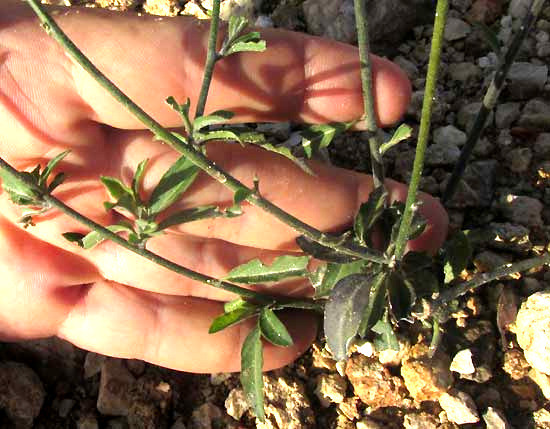
The flowers were so small and slender that they were easy to overlook, but they could be found at some of the gnarly inflorescence branch-tips, as seen below:
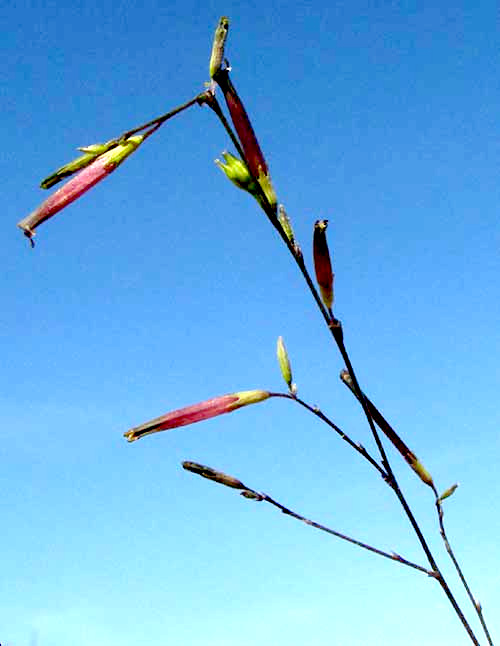
Closer up, the corolla reveals itself as little more than a long, slender, purplish cylinder with very modest lobes for petals, and the fruit shows itself as a classic capsule containing several seeds, arising inside a classic calyx with five sepals, as shown below:
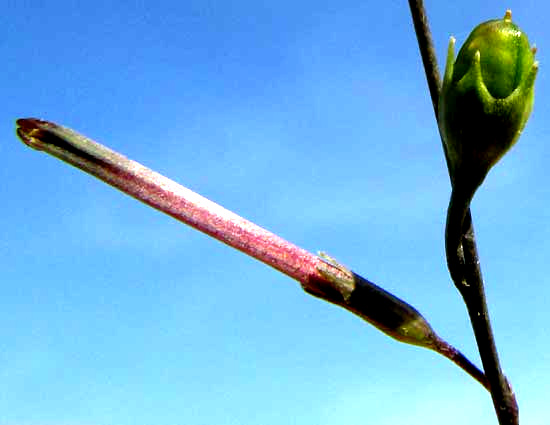
Below, a broken-open flower displays two of five stamens above which rises a slightly longer stigma-tipped style:

As blunt fingernails made the above field-dissection, something unusual was noticed at the corolla's mouth. The details were so minute that I couldn't see what was going on until the image came onto the laptop screen, shown below:

What are those club-like things arising between the corolla lobes? Seeing this, I knew I had something special.
It took extra time to identify this plant because at first I couldn't figure out which plant family it belonged to. Because of its capsular fruits and its growing in such thin soil atop limestone, initially I thought it was a member of the Pink Family, the Caryophylaceae, along with the sandworts, genus Arenaria, we've seen up North. However, the Pink Family is mostly a temperate and cold-weather family poorly represented in the tropics, plus they are opposite-leafed while our plant seems to produce one leaf per node, and it wasn't either of the two Pink Family members listed for the Yucatan.
My next bet was that it was in the Figwort or Snapdragon Family, the Scrophulariaceae, in which I've seen capsular fruits just like this, but it wasn't any of the Yucatan's several "scroph" species, either. On the Phylogenetic Tree of Life the Nightshade or Tobacco Family, the Solanaceae, stands right next to the scrophs, so I went looking there, though I'd never seen anything in that family with flowers bearing such appendages between their corolla lobes. And, to my amazement, it turned out to be in that family.
It's SCHWENCKIA AMERICANA, though poorly documented on the Web, widely distributed in tropical America and, curiously, humid tropical Africa. It doesn't seem particularly adapted to thin, sun-baked soil atop limestone, but rather just flexible enough to be weedy in unexpected places like our limestone quarry.
For years taxonomists debated which family the genus Schwenckia belongs to. The great Linnaeus in the 1700s pegged it as a member of the Nightshade Family, but most influential botanists of the time placed it in the Figwort/Snapdragon Family, as I had done. As more information came in, the consensus grew that Linnaeus had been right with his Nightshade Family, the Solanaceae.
So, what are those club-like things arising between corolla lobes? I find one paper calling them glands, and I guess that that's right. The flowers look like they're pollinated by moths or butterflies with slender proboscises, but what good do such glands serve to a butterfly or moth? Maybe they attract pollinators such as small beetles and ants to the corolla's mouth, where they might be further enticed to enter the corolla tube to find fragrant nectar at the bottom, and do some pollinating on their way down? However they work, they're appropriately weird for a species that's so unique that it's the only representative of its genus.
In Africa, Schwenckia has been used in traditional medicine, and researchers have confirmed its anti-inflammatory properties.
Otherwise, not much seems to be known about it, so we're probably contributing valuable pictures and data here.
from the January 7, 2018 Newsletter issued from Rancho Regenesis in the woods ±4kms west of Ek Balam Ruins; elevation ~40m (~130 ft), N20.876°, W88.170°; north-central Yucatán, MÉXICO
SCHWENKIA, VERSION 2
In a densely weedy, shaded thicket at the rim of one of the rancho's sinkholes, or cenotes, a certain spindly looking herb turned up looking too delicate to compete with such coarse weeds as surrounded it. It was so embedded within the vegetation that only parts of the plant could be seen at one time. The diffuse, sparsely flowered inflorescence that had caught my eye is shown below:
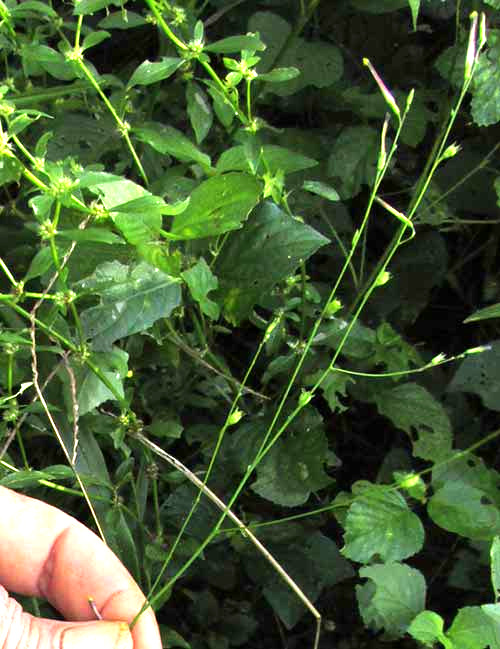
Notice the very slender, purplish flowers at the top, and the ovoid, capsular fruits at the bottom. We've seen Gerardia/Agalinis species with such wide-open inflorescences and similar fruits, but this plant's flowers are all wrong for that. When I sought clarification by looking for leaves down below, what I found turned out to be fairly characterless, as shown below:
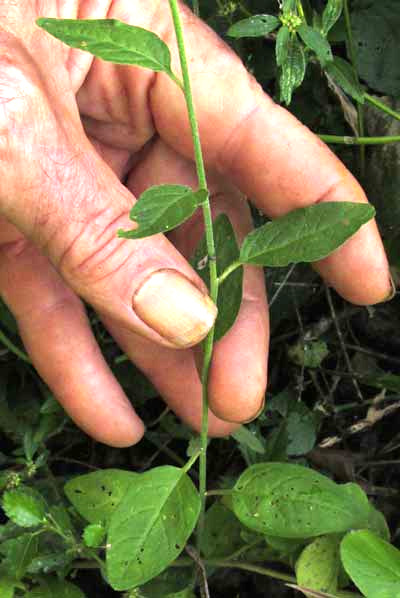
A fruit close-up revealed nothing special, either, as seen below:
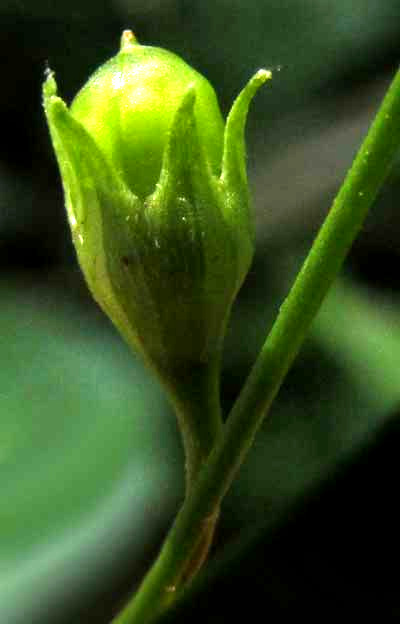
So, back to that skinny flower, shown close-up below:
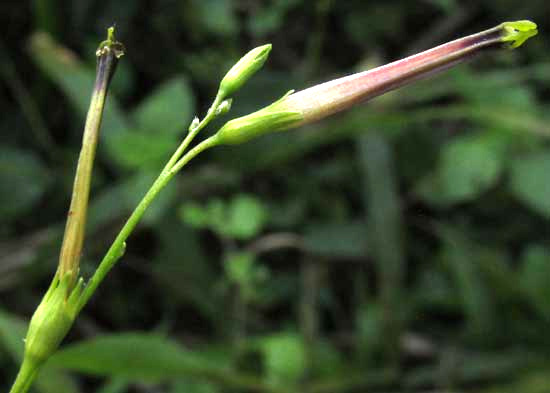
What plant families can produce capsular fruits, alternate leaves with no lobes or serrations along their margins, and tubular flowers like these? There's the Figwort or Snapdragon Family to which Gerardia/Agalinis belong, but flowers in that family usually are asymmetrical, or "irregular," while these are regularly symmetrical. Still, I reasoned, this species must be in a family close to the Snapdragon Family.
On the Phylogenetic Tree of Life, the Snapdragon Family stands next to the Black Nightshade or Tomato Family. When I remembered that, I remembered something else, too: I've seen this plant before, and also then I'd had a hard time figuring out what family it belonged to. And though that earlier plant had borne identical flowers and fruits, it had occupied a different environment, and presented a completely different overall appearance -- as documented in the above entry.
So, this is Schwenckia americana, which for want of a better name we just call Schwenkia.
One feature of the plant not already detailed above is Schwenkia's medicinal value. The Black Nightshade Family, or Solanaceae, to which the species belongs is famous for its species often containing powerful compounds that deter animals from feeding on the plants. In fact, research in the 1960s confirmed that Schwenkia has an interesting brew of alkaloids, glycosides, something called schwenckioside, and sapogenins. The sapogenins displayed effects on the heart. Also, simple water extracts of the leaves showed antimicrobial activity toward certain disease-causing organisms.
Therefore, it's not surprising that traditionally in various cultures the plant has been used for a variety of ailments, including to cure coughs and other lung problems, as a purgative, against intestinal worms, headaches, sinus problems, conjunctivitis, swellings, arthritis, stomach disorders, hernias, gonorrhea, measles, chickenpox, athlete's foot, fever... the list goes on and on.
In keeping with the observation that often compounds that are medicinal in one dosage are toxic at higher concentrations, in some places the whole plant has been pounded to pulp for use as fish poison.